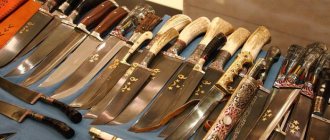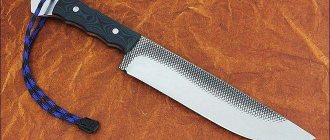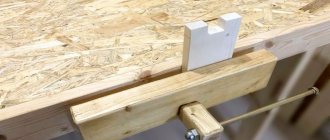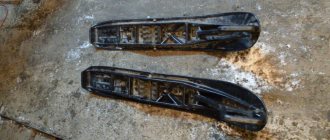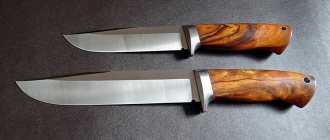A high-quality knife is an indispensable attribute of equipment for any hunter, fisherman or outdoor enthusiast. There is such a wide range of hunting knives on the modern market that choosing the right model is not difficult. However, many people prefer to make blades themselves. The handle for the knife requires special attention, because it must be comfortable, durable and resistant to aggressive environmental factors.
Our article is intended specifically for those who prefer to make the tools necessary for hunting on their own. Today we decided to dwell in more detail on the manufacture of a handle for a hunting knife and consider the main stages of this process, as well as pay attention to the materials that can be used for production.
Shape and properties of a knife handle
If the knife is equipped with a bad handle, it will not fully perform its functions. This does not depend in any way on the grade of steel on the blade and its sharpening. Due to the shape of the handle, various properties of the knife are achieved: convenience, balancing, maneuverability and ease of use of the tool.
The size and material of the handle depends on preferences and national traditions. Knives of Finnish origin are traditionally made from Karelian birch. It does not swell or deteriorate, and also does not sink in water. The purpose of the tool plays a vital role.
A universal handle is quite suitable for a fishing or kitchen knife. For cutlery and travel knives, an oval handle shape is most suitable. It is perfect for cases where you need to hold an object for a long time.
Handle mounting type
There are two types of attachment of the handle to the blade: mounted and overhead. Each installation method has its own advantages and disadvantages. To make the right choice, you need to rely on the scope of application of the product. These types of installations should be considered in more detail.
Mounting
Mount-on mounting technology involves mounting a narrow shank onto a hollow handle. Which is made from a single piece of material. Fastening is done by any available means, the most common is filling with epoxy resin.
There is also a type of mounted mounting - a stacked handle. In this case, plates of material with holes in the center are strung onto the shank. This handle can be made of any shape and size. But there is one drawback - the low reliability of attaching the handle to the shank.
Mounted handle mounting.
Surface mounting
The overhead mounting method involves attaching the plates to the blade shank using screws or rivets. For such a handle, you need to take care of the handle even at the stage of blade formation.
The shank should be wide and shaped to match the hand.
Making such a handle is not very difficult; you will need two pads made of any material. Which will later be riveted on the shank. But it should be taken into account that the choice of handle shape is limited and the overhead handle has greater thermal conductivity.
This installation is well suited for beginners, it is less hassle and is quite practical. It should also be taken into account that a product with such a handle installation will be much heavier than a knife with a mounting method.
Overhead mounting of the handle.
Additional accessories
Such devices most often include a trench and a sharpener, as well as secret holes in the back of the knife and pockets on the sheath.
Trenchik
A special loop for attaching the sheath to a belt. When making a trench coat, various materials are used: rope, cord, strip of leather. Making a sheath with your own hands allows you to make a trench coat from any available material.
The trench coat can be glued, sewn, attached with a screw from the inside of the sheath, the main thing is to make a loop with a margin for any belt width. The length must be selected individually.
Sharpener
A small, fine-grained block of stone used for sharpening a knife. The sharpener is attached to the sheath and is necessary when using the blade for a long time.
Pockets
Making a knife and a sheath with your own hands allows you to fully equip it to your taste. But it is worth carefully considering the necessity, and most importantly, the practicality of this or that pocket.
When making handles for knives, some craftsmen leave a cavity in the back, into which small objects can also be placed.
Three main types of knife handle materials
You don't need to be a knife-making guru to understand that there are many materials available for making handles of any type of mounting. In general, all of them can be combined into 3 main groups:
Synthetic materials
Most of these modern materials were created specifically for knife handles. They have such positive properties as: lightness, ductility and strength. Trying to achieve maximum positive qualities, scientists from all over the world are constantly improving their developments. And there are quite a lot of materials for handles of artificial origin.
Natural materials
Most of them have been used by humans to mount handles for several hundred years. They played an important role in the history of knife making. Handles made from natural materials belong to the class of vintage products.
Metal materials
This is a durable and strong option for creating a handle. Such products are widely used for hiking or tourism purposes. Handles for cutlery are also made of metal.
Metal handles
The main steels for making metal handles are stainless steel, titanium and aluminum. This is, of course, rudely said; steel is present in the handle not in its pure form, but in the form of various alloys. Such mixtures occur with other metals or with non-metallic elements.
Alloys are actually more practical than pure steel. They are more durable and have stronger tensile strength. And thus the cost of the product is reduced. The main disadvantage of metal handles is their slippery structure, but various notches on the surface of the alloy save them.
Which installation method do you think is better?
On horsebackInvoice
Stainless steel
Stainless steel itself is an alloy based on copper and iron. The production of such an alloy is relatively inexpensive. It is quite widely used for making handles. Stainless steel is not easy to scratch.
It is also difficult to make dents on it. But at the same time it makes the knife heavier.
It is used to make folding knives for everyday use. A huge advantage of the alloy is its good corrosion resistance. But still, stainless steel handles require a little maintenance.
Good corrosion resistance does not mean that the product will not rust. Stainless steel handles become slippery when wet. To increase the grip of the handle, some manufacturers make rubberized inserts.
Knives with stainless steel handles.
Aluminum
Aluminum alloys are also very popular. It is quite durable, cheap and lightweight. It belongs to non-ferrous metals, so it resists corrosion well. But the delicacy of the material affects the appearance of scratches and dents.
There are quite a few alloys with an aluminum base. Marking T6-6061 is considered the most common. The alloy is based on aluminum and other elements such as magnesium, nickel and copper. By anodizing, such a pen can be obtained in any color.
When wet, such a handle becomes slippery. For this purpose, manufacturers make special invoicing of aluminum products. This helps to have a good grip between the hand and the handle.
Aluminum products.
Titanium
Titanium alloys are the strongest and most durable. Products made from it do not rust, because it is a non-ferrous metal. The alloy has high strength and lightness. It is often used on steel blades for added protection.
Ti6Al4V is considered a very popular alloy. It contains 6% aluminum, 4% vanadium and up to 90% titanium. The alloy has poor thermal conductivity, so you can work with it in the cold. It is also used to make locks on folding knives.
Lowers with titanium handle.
Natural materials
Natural materials have been used for thousands of years. Not only the knife develops, but also its handle. These materials are not the most durable, waterproof or durable. But they are often considered traditional. They look quite aesthetically pleasing compared to synthetic products.
Bone handle
The material dates back many hundreds of years to its use as a handle. Today, such products belong to fashionable and non-standard designs.
Cow bone is mainly used to make such pens.
In reality, there are many ways to decorate such a product. The animal bone handle can be painted any color or textured to improve grip. People like bone handles.
It is quite cheap to make and is considered a traditional material. But the fragility of the bone should be taken into account; heavy loads on such a blade are contraindicated. The material is seaweed and can be very slippery when wet.
Bone handles.
Leather
Leather handles have recently lost their popularity. The principle may be to wrap a leather strap around the shank. This manufacturing method is not expensive. A handle made from pieces of leather will look more expensive.
Such a handle is difficult to manufacture and requires the necessary experience. But the result is above all praise. It should be remembered that a leather handle will quickly absorb all foreign liquids. It is strictly not recommended to clean fish with such a knife - you will not be able to get rid of the smell later.
Leather handle.
Nacre
In the list of natural materials, this is the most beautiful option. Knives with mother-of-pearl handles are very popular among collectors. The material is not durable and slippery when wet. Thus, the raw material is not suitable for survival knives or tactical products. The high cost of mother-of-pearl products also affects this.
Knives with mother-of-pearl handles.
Deer antler handles
It is preferable to use animal antlers that have been shed naturally. The option is very stylish and unusual. This material is used mainly on hunting knives. Because a deer antler can be a trophy obtained from a hunt.
Like bone, deer antler has a porous structure. Therefore, products made from it are not intended for high loads; the handle may simply crack or fall apart. But the uniqueness of the type of product gives the owners of such knives a high status.
Handle made of deer antler.
Tree
Among natural materials, wood is considered the most popular raw material for making knife handles. Such a handle can be strong and durable. Very beautiful texture makes the products popular among collectors.
There is a great variety of trees of varying hardness, color and texture.
Therefore, there are very great opportunities to make a unique handle. But not all tree species are suitable for handles. For example, soft wood, an example of which is pine needles.
Hardwood is more suitable for these purposes. These include oak, beech or walnut. Another option is to buy stabilized wood. It is reinforced with resins, which will make the handle more durable. Also, such a handle will be moisture resistant.
Wooden handles.
Birch bark
Birch bark is considered the simplest and most affordable material. To work with it you will need a minimum set of tools. Birch bark handles are resistant to rot and mold due to the presence of a natural antioxidant - tar.
The handle can be used in both cold and hot weather, due to the low thermal conductivity of the material. The handle is made from birch bark, cut into pieces. The typesetting method of installation is used. The pieces are placed one by one on the shank, gluing them with epoxy resin or glue.
Knives with birch bark handles.
Synthetic materials
The scientific minds of the planet do not stand still. They invent new materials for making handles. They try to increase grip, increase durability, and reduce the weight of the handle. There are many brands and names of synthetic materials.
G-10
The material is very famous among knife enthusiasts. It is also known as fiberglass composite. The production technology involves soaking pieces of fiberglass in resin and then compressing them. It is considered the best material for the handle.
It is used to make fixed blade knives. And for folding products, handle linings are made. The material is extremely durable, waterproof and lightweight. A handle made from this raw material has all the necessary properties for making survival blades.
There are special notches on the handle, this allows you to increase grip on the hand. The characteristics of G 10 are similar to carbon fiber, but at a much lower price. The material was originally manufactured for use in electronic circuit boards.
G-10 handles.
Micarta
The material is quite popular for making knife handles. It is strong, durable and safe. Micarta is a phenolic material. The manufacturing process involves soaking pieces of fabric, paper or canvas in epoxy resin.
The texture of the handle depends on the components used. This means that the result will look different, but the strength of the final product will not be affected. The resulting handle is smooth; in order to hold it well in the hand, notches are made on the surface.
knives with micarta handles.
Zytel (FRN)
The abbreviation FRN stands for glass fiber reinforced nylon. This material can be cast into any shape. The raw material has high wear resistance, moisture resistance and can withstand any bending in any direction.
All nylon strands in the composition are arranged randomly. This is what makes them durable in all directions. The most famous FRN manufacturer is Zytel®. The material is not expensive and is considered a very good budget raw material.
Reinforced fiberglass handles.
Paracord
Paracord material is rapidly gaining popularity; it can be found in many knife manufacturers.
Various companies sell separately blades with a shank, on which you can optionally wrap paracor and make a unique handle.
The material was originally intended for the manufacture of parachute lines. But today such rope is used for survival blades. You can unravel it at any time and you have a cord on your hands for any purpose.
Rope handles - paracord.
Carbon fiber/Carbon
The material has proven itself in the production of handles. It consists of carbon strands that are woven together and then turned into resin. Such raw materials are high-tech materials. It is considered one of the easiest.
And at the same time it is incredibly durable. It is also quite attractive in appearance. Also, products made from this material come in various colors. Carbon fiber can be stronger than micarta and G-10 in some cases. But it has high fragility, so you need to be careful with such a handle.
Carbon fiber knife handles.
Kraton
The material is a thermoplastic elastomer. It is a raw material made from synthetic rubber. Artificial rubber craton fits well in the hand and has high moisture resistance. Compared to natural rubber, it is resistant to heat.
Handles made of this material come in various types and sizes. Raw materials do not have many color options. But there is one significant drawback: the material has a porous structure. This is why it absorbs odors. The handle may lose its attractive appearance a little over time.
Kraton handles.
Handle decor
Decorating the handle of a knife is a separate specificity of the work. There are several ways to decorate a wooden knife handle:
- Drawing with fire - pyrography. Most men are familiar with wood burning from school;
- Scrimshaw is a special burning technique in which a person literally works by touch. The pattern appears later, after painting the product;
- Carving is a figurative work with which you can recreate Celtic themes, ancient Phoenician writings, and runes.
The decor can be combined. There may be inserts of precious stones, leather trim, or the use of several techniques simultaneously. All this allows you to recreate exclusivity. Moreover, handmade is always a work of art.
Pyrography
Thread
Scrimshaw
Braid
Nothing better than paracord cord and leather cord for braiding has yet been produced. At first glance, it may seem that braiding is a rather monotonous option for decorating a knife. However, this is not so - there are many braiding patterns that create different textures and patterns of the product:
- Dense and ordinary windings;
- Weaving "Turkish head";
- Popular weaving "Cobra";
- Technique "Spike";
- "Snake Knot"
Masters come up with their own unique weaving techniques, combining several well-known ones. You can also use different colors and create a pattern. This method can achieve design uniqueness.
Leather trim
In general, leather knife handles are original and durable. Craftsmen offer several ways to decorate a knife with leather. Some wrap the product with a narrow leather strap coated with epoxy. This technique allows you to recreate a special relief. In addition, after processing, the knife lies comfortably in the hand.
To fit a wooden handle, you need to clean and degrease its surface. Then apply shoe glue and let it dry. A piece of leather is wrapped around the handle with an overlap of 1 cm. Glue is immediately applied and dried. After this, you should heat it over the stove, tighten it on the handle, placing that same overlap on the side of the axis. Use a sharp blade to remove any scraps and carefully align the edges of the leather. If the technology is followed correctly, the joint between the edges will be invisible, and the product will last for many years.
Making your own handle
It may happen that the handle on the knife may deteriorate. Do not rush to throw away the blade, especially if it is dear to you. Using inexpensive materials, you can try to make a handle with your own hands. The most budget-friendly and simplest option would be to make a handle from wood.
Required Tools
Let's consider the option of mounted mounting of the handle. The method is quite simple and does not require special tools. And we need the following:
- Sander;
- wood for the handle;
- blade with tang;
- holdfast;
- epoxy resin;
- wood hacksaw.
Requirements for size and shape
The handle should be made so that the knife fits comfortably in the hand. The most convenient option is for the handle to extend 2-2.5 cm from the arm circumference. The optimal option for a hunting knife is that when gripping, the thumb should not touch the middle, ring and little fingers.
Complex handles with grooves for fingers seem comfortable only at first glance. And it should be taken into account that such a pen is not easy to make. You should choose a straight or barrel-shaped version, this will allow you to produce a universal type of cutting.
Comfortable knife grip.
Product drawings
To make a mounted handle, you will need a small wooden block, which is then shaped using a hacksaw in accordance with the template. To make the process easier, here are a few examples of finished product drawings. Already in accordance with the drawing, the required shape of the handle is cut out.
Various product drawings. with dimensions.
Attaching the handle to the blade
The mounted handle is attached to the blade using epoxy resin or good glue. It is necessary to drill a hole in the wooden blank; the blade shank will be inserted there.
After trying the parts together, epoxy resin should be poured into the hole.
To prevent adhesive from getting on the blade, it should first be wrapped with masking tape. Then you need to place the product in a carpenter's vice for 24-48 hours until the glue dries completely. At the final stage, the handle is turned from a block of the required shape.
Installation of a horse-drawn handle.
Making a knife from a 9HF saw
In this article we will not focus on the shape and design of the blade, the type and width of the sharpening, etc. We believe that we already have a finished project or sample and will focus on the production itself
In order for a homemade hunting knife to meet the basic requirements for such blades, it is recommended to make it from high-carbon alloy steels. For example:
- 9ХФ – tool alloy steel, used for the manufacture of frame, band and circular saws, punches, trimming dies and a number of other tools. Usually saw blades are used as blanks;
- Р6М5 – high-speed alloy steel of high strength. It is used for the manufacture of many types of cutting tools, drills, saw wheels, the latter can be used to make a workpiece;
- 65G – spring steel, with high wear resistance, can be blued and blackened. They make springs, springs, gears, etc. In addition to sheets, rear springs of trucks are used for blanks. Considered one of the cheapest knife materials;
- X12, R3M3F2 and a number of others are also suitable.
The material for the workpiece can be taken from the above products, although now on the Internet you can order a plate for the workpiece from almost any steel. As a recommendation, take a pendulum saw blade for metal, the usual dimensions are 400x30 mm, thickness 2 mm, rough surface, color black or gray.
If you want to make a homemade knife at home, in addition to the material for the workpiece, we will need:
- Angle grinder (grinder)
- Wheels for it, cutting wheels for alloy steel, for example inox A54S BF, sharpening and grinding.
- Drill or drilling machine
- Vise
- Pobedite and other special drills
- Files and diamond file
- Emery machine (very desirable).
The knife making process will be as follows:
- Based on the drawing or sample, we cut out a blade template from cardboard.
- We place the template on the canvas and trace it with a pencil; if necessary, the outline can be drawn with a carbide scriber.
- So, a start has been made. We put a cutting wheel for alloy steel on the grinder and start cutting out the workpiece.
- We cut the workpiece slowly so as not to overheat and not let go of the edge of the blade. We are absolutely satisfied with industrial hardening in terms of hardness and elasticity. To do this, we cut strictly the end of the disk into the end of the metal, then it can be released.
- When the workpiece is cut, we put a sharpening wheel on the grinder, and with it we process and polish the entire contour of the workpiece, align the lines, and remove the handle. At the same time, we do not linger in place so as not to overheat the metal.
- Then we install a flap sanding disc on the grinder and remove the blade slopes. For the steel used, the optimal height of the descents will be 9 mm. Subsequently, the blade is ideally positioned into the lens. Let's not rush, remember about overheating. If you have an emery machine, it is more convenient to do this on it.
- After the blade is completely formed, polish it using an appropriate wheel.
The handle of the knife can be wound using paracord or made of wood; in the latter case, we drill holes in the handle according to a template, according to a sample or drawing. Holes are drilled using special drills with accompanying cooling using oil. It is more convenient to do this on a drilling machine.
To simplify the process, holes are first drilled with small diameter drills and then gradually drilled out to the desired size.
Recommendations for design and finishing
The unique design of the handle will help emphasize the individuality of the product. When decorating the handle, the master can show unlimited imagination and creativity. Engraving, figured cutting and braiding are considered traditional.
You can thread a cord or brush into a special hole under the lanyard. A cast or figured pommel looks pretty good on the handle. You can apply a pattern to the handle using a burner. You can also use paints and decorate the black.
What materials for the handle are better?
NaturalSynthetic
What characteristics should a tree have?
Craftsmen rely not only on the decorative qualities of wood, but also on the properties of the material. The following points are considered the main and most important:
- The strength of the raw material is very important. The handle of any knife is subject to constant stress. The wood should not warp or crack during operation;
- The moisture resistance of wood is considered important. The master should pay special attention to this. The knife will inevitably end up in a damp environment.
Handles made from various types of wood.
Stabilized hornbeam
This is generally a cool tree that can perfectly replace ebony. Hornbeam wood is impregnated with resins and becomes black. Stabilized hornbeam handles are very strong, it’s not for nothing that the British called hornbeam ironwood. Stabilized hornbeam bars are inexpensive, approximately at the same level as Caucasian walnut bars.
Suitable tree species for knife handles
Everyone knows that a knife consists of two most important components - the handle and the blade. The second can be purchased ready-made. But for the handle you should choose a type of wood of decent quality.
There are many types of trees, they have different mechanical and physical properties.
The following trees are mainly used: acacia, walnut, oak, boxwood, wenge and birch. It doesn’t matter which tree you choose, the main thing is that it is well dried. At the final stage of making the handle, craftsmen impregnate it with oils, wax or drying oil.
This protects against external negative influences and significantly improves the decorative qualities of the material. Thus, the life of the product is extended. Exotic trees are used to make expensive handles.
Birch wood for knife handle
The material is very good and easy to work with. But its only drawback is its lack of expression. The knife handle will look quite simple. But this material perfectly emits ivory. Lightness and affordability are the most important advantages of raw materials.
Birch knife handles.
Oak wood for making a handle
This material is very resistant to external irritants, has good strength and will last a long time. Oak is more difficult to process than some other tree species. But this matter can be corrected with modern equipment of the master. The raw material has a very beautiful pronounced texture.
Oak handles.
Eben
One of the most expensive types of wood in the world. The average age of wood maturation is 500-600 years. The most valuable is Ceylon ebony, which is black in color. The wood of this tree is hard and dense, with practically no pores. When cutting down ebony, the bark and sapwood, which makes up about 70% of the trunk, are removed from above. The remaining 30% is this very ebony tree.
